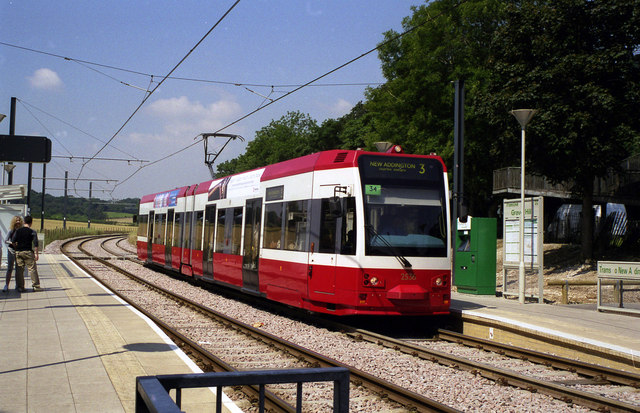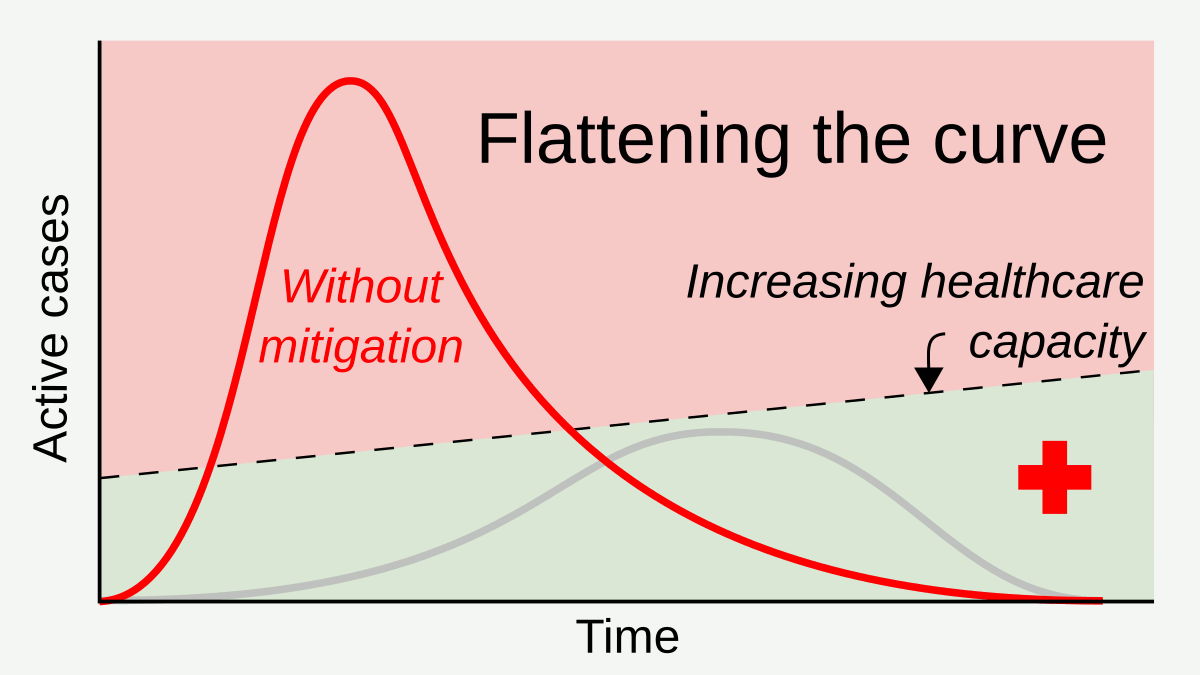|
Therapia Lane Tram Stop
Therapia Lane tram stop is a light rail stop on the Tramlink service in Croydon, close to the Purley Way commercial area. The stop is in the London Borough of Sutton close to the boundary with Croydon. It is one of two Tramlink stops within Sutton borough, the other being Beddington Lane. Just to the west of the stop is Therapia Lane Depot Staff Halt, a two platform stop used only by staff getting to or from Therapia Lane depot, and not permitted for public use. However, since 21 March 2020, the stop has been out of use due to its narrow, short platforms preventing social distancing during the COVID-19 pandemic. The staff halt's future is uncertain given it is less than from the public stop. Services The typical off-peak service in trams per hour from Therapia Lane is: * 6 tph in each direction between and * 6 tph in each direction between and Wimbledon Services are operated using Bombardier CR4000 and Stadler Variobahn Trams. Connections London Buses routes 463 and ... [...More Info...] [...Related Items...] OR: [Wikipedia] [Google] [Baidu] |
Tramlink
Tramlink, previously Croydon Tramlink and currently branded as London Trams, is a light rail tram system serving Croydon and surrounding areas in South London, England. It is the first operational tram system serving the London region since 1952. Tramlink is presently managed by London Trams, a public body part of Transport for London (TfL), and has been operated by FirstGroup since 2017. It is one of two light rail networks in Greater London, the other being the Docklands Light Railway. Tramlink is the fourth-busiest light rail network in the UK behind the Docklands Light Railway, Manchester Metrolink and Tyne and Wear Metro. Studies for the delivery of a modern-day tram system in Croydon began in the 1960s and detailed planning was performed in the 1980s. Approval of the scheme was received in 1990 and, following a competitive invitation to tender, tender process, construction and initial operation of the tramway was undertaken by ''Tramtrack Croydon'' (TC) via a 99-year Priva ... [...More Info...] [...Related Items...] OR: [Wikipedia] [Google] [Baidu] |
COVID-19 Pandemic
The COVID-19 pandemic (also known as the coronavirus pandemic and COVID pandemic), caused by severe acute respiratory syndrome coronavirus 2 (SARS-CoV-2), began with an disease outbreak, outbreak of COVID-19 in Wuhan, China, in December 2019. Soon after, it spread to other areas of Asia, and COVID-19 pandemic by country and territory, then worldwide in early 2020. The World Health Organization (WHO) declared the outbreak a public health emergency of international concern (PHEIC) on 30 January 2020, and assessed the outbreak as having become a pandemic on 11 March. COVID-19 symptoms range from asymptomatic to deadly, but most commonly include fever, sore throat, nocturnal cough, and fatigue. Transmission of COVID-19, Transmission of the virus is often airborne transmission, through airborne particles. Mutations have variants of SARS-CoV-2, produced many strains (variants) with varying degrees of infectivity and virulence. COVID-19 vaccines were developed rapidly and deplo ... [...More Info...] [...Related Items...] OR: [Wikipedia] [Google] [Baidu] |
London Buses Route S4
This is a list of Transport for London (TfL) contracted bus routes in London, England, as well as commercial services that enter the Greater London area (except coaches). Bus services in London are operated by Arriva London, Go-Ahead London (Blue Triangle, Docklands Buses, London Central and London General), Metroline, First Bus London, Stagecoach London (East London, Selkent and Thameside), Transport UK London Bus and Uno. TfL-sponsored operators run more than 500 services. Examples of non TfL-sponsored operators include, but are not limited to: Arriva Herts & Essex, Arriva Southern Counties, Carousel Buses, Diamond South East, Go-Coach, First Beeline, Metrobus, Stagecoach South, Thames Valley Buses and Reading Buses. Classification of route numbers In Victorian times, people who took the bus would recognise the owner and the route of an only by its livery and its line name, with painted signs on the sides showing the two termini to indicate the route. Then, in 1906, Geor ... [...More Info...] [...Related Items...] OR: [Wikipedia] [Google] [Baidu] |
London Buses
London Buses is the subsidiary of Transport for London (TfL) that manages most bus services in London, England. It was formed following the Greater London Authority Act 1999 that transferred control of London Regional Transport (LRT) bus services to TfL, controlled by the Mayor of London. Overview Transport for London's key areas of direct responsibility through London Buses are the following: * planning new bus routes, and revising existing ones * specifying service levels * monitoring service quality * management of bus stations and bus stops * assistance in 'on ground' set up of diversions, bus driver assistance in situations over and above job requirements, for example Road Accidents * providing information for passengers in the form of timetables and maps at bus stops and online, and an online route planning service * producing leaflet maps, available from Travel Information Centres, libraries etc., and as online downloads. * operating NMCC, London Buses' 24‑hou ... [...More Info...] [...Related Items...] OR: [Wikipedia] [Google] [Baidu] |
Low-floor Tram
A low-floor tram is a tram that has no steps between one or more entrances and part or all of the passenger cabin. The low-floor design improves the accessibility of the tram for the public, and also may provide larger windows and more airspace. A low-floor tram allows accessible level access from curb (road), curb level platforms. Level access can also be achieved either by using a high-floor vehicle serving high-platform stops. Currently both types are in use, depending on the station platform infrastructure in existing rail systems. Some systems may make use of former railway alignments where use of existing high platforms is desirable, while others, particularly new systems, may not have the space to site high-level platforms in urban centres. Low-floor tram configurations Trams traditionally had high floors, and articulated tram designs evolved with low-floor centre sections. Examples of this design are Trams in Amsterdam, Amsterdam 11G/12G-trams and the Kusttrams in Belgium ... [...More Info...] [...Related Items...] OR: [Wikipedia] [Google] [Baidu] |
Stadler Variobahn
The Stadler Variobahn (formerly sold as the ABB Variotram, Adtranz Variotram and Bombardier Variotram) is a German-designed model of articulated low-floor tram and light rail vehicle. Since its introduction in 1993, the Variobahn has been manufactured variously by ABB, Adtranz, Bombardier Transportation, and since 2001 by Stadler Pankow. As of 2009, 254 trams have been ordered, with an additional 110 on option. A unit costs about €2.5 million. Operators include the Graz Holding, the Bergen Light Rail, the Chemnitz Tramway, Verkehrsverbund Rhein-Ruhr, the Rhine Neckar Area Tramway and London Tramlink. History Prototypes and early deliveries The Variotram was first developed by ABB (ASEA Brown Boveri) at Henschel and a prototype was launched in 1993 for the Chemnitz tramway in Germany, operated by Chemnitzer Verkehrs-Aktiengesellschaft (CVAG). The serial delivery, with minor modifications, was made between 1998 and 2001—bringing the total number of units for Chemnitz ... [...More Info...] [...Related Items...] OR: [Wikipedia] [Google] [Baidu] |
Bombardier CR4000
The Bombardier CR4000 is a 76% low floor model of the Bombardier Flexity Swift trams operated by Tramlink in London. They are based on and very similar in appearance to the K4000 used on the low-platform routes of the Cologne Stadtbahn network. Built between 1998 and 2000, the trams entered service in the spring of 2000. History 24 trams were ordered from Bombardier Transportation and built at its factory in Vienna, Austria between 1998 and 2000. The first tram, 2530, was delivered to Therapia Lane depot on 13 September 1998, with testing beginning soon afterwards. Although service was due to begin in November 1999, delays in the construction of the line meant that the first tram entered passenger service on 10 May 2000. The trams are numbered 2530 through to 2553, following on from the highest numbered tram in the original London Transport numbering system, 2529, which was scrapped in 1952. All entered service in a red and white livery except for 2550, which was painted in ... [...More Info...] [...Related Items...] OR: [Wikipedia] [Google] [Baidu] |
Transport For London
Transport for London (TfL) is a local government body responsible for most of the transport network in London, United Kingdom. TfL is the successor organization of the London Passenger Transport Board, which was established in 1933, and History of public transport authorities in London#London's transport authorities, several other bodies in the intervening years. Since the current organization's creation in 2000 as part of the Greater London Authority (GLA), TfL has been responsible for operating multiple urban rail networks, including the London Underground and Docklands Light Railway, as well as London's London Buses, buses, Taxis of London, taxis, principal road routes, cycling provision, Croydon Tramlink, trams, and London River Services, river services. It does not control all National Rail services in London, although it is responsible for London Overground and Elizabeth line services. The underlying services are provided by a mixture of wholly owned subsidiary companie ... [...More Info...] [...Related Items...] OR: [Wikipedia] [Google] [Baidu] |
Social Distancing
In public health, social distancing, also called physical distancing, (NB. Regula Venske is president of the PEN Centre Germany.) is a set of non-pharmaceutical interventions or measures intended to prevent the spread of a contagious disease by maintaining a physical distance between people and reducing the number of times people come into close contact with each other. It usually involves keeping a certain distance from others (the distance specified differs from country to country and can change with time) and avoiding gathering together in larger groups. By minimising the probability that a given uninfected person will come into physical contact with an infected person, the disease transmission can be suppressed, resulting in fewer deaths. The measures may be used in combination with other public health recommendations, such as good respiratory hygiene, use of face masks when necessary, and hand washing. To slow down the spread of infectious diseases and avoid overb ... [...More Info...] [...Related Items...] OR: [Wikipedia] [Google] [Baidu] |
London Borough Of Sutton
The London Borough of Sutton () is an Outer London London boroughs, borough in south London, England. It covers an area of and is the 80th largest local authority in England by population. It borders the London Borough of Croydon to the east, the London Borough of Merton to the north and the Royal Borough of Kingston upon Thames to the north-west; it also borders the Surrey boroughs of Epsom and Ewell to the west and Reigate and Banstead to the south. The local authority is Sutton London Borough Council. Its principal town is Sutton, London, Sutton. The borough has had some of the schools with the best results in the country. Low levels of recorded crime have been a feature of the borough, being among the lowest in Crime in London, London. The London Borough of Sutton was one of the four "vanguard areas" selected in 2010 for the Big Society initiative. History The area of the modern borough broadly corresponds to the five ancient parishes of Beddington, Carshalton, Cheam, Su ... [...More Info...] [...Related Items...] OR: [Wikipedia] [Google] [Baidu] |







